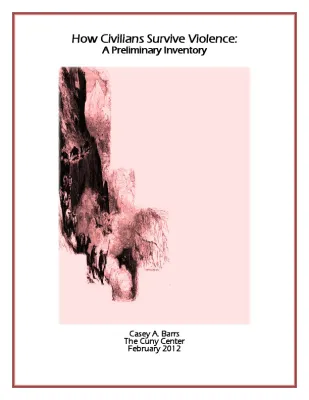There will always be mass violence. There will always be horrific times when we “outsiders” cannot shield civilians despite our avowed responsibility to protect them. Millions died amid internal conflicts in the last 15 years, and there is absolutely no guarantee that the next 15 years will be any better. That is the starting point of this paper: our capacity to protect is very much in doubt. Even when we do “save” civilians it is very often only because they saved themselves first—surviving violence by their wits and wiles for months or years, and then running a deadly gauntlet to reach our camps or safe havens.
Many observers note the critical importance of civilian self-protection, but it appears there have been very few systematic attempts to inventory their tactics and strategies. By and large we appreciate civilians’ capacity for self-preservation or “resilience” but scarcely act upon it. This preliminary inventory cites protections that civilians the world over have learned time and again as they survive and serve others alone amid violence. Some types of actions cited here have alone saved millions of lives.
This document has three sections: local safety, local sustenance, and local services.
Life-critical sustenance and services are an inseparable part of this because civilians often see them as central to their security, often take physical risks to obtain them, and often die in far greater numbers from the collapse of such elemental things than from direct physical violence. The biggest killers amid conflict are not guns or blades but malnutrition and disease—which at times can be anticipated and prepared for.
Each section begins with conventional local efforts to engage dangerous actors and influence events. These good efforts have limits. (In 2009, the ICRC interviewed four thousand people in eight war-torn countries. When asked what civilians living in areas of armed conflict need the most, only 3% chose “to influence decisions that affect them.”) Each section then progresses toward the less conventional actions civilians attempt. These are efforts to survive the actors and events that they cannot influence. These too have limits—but tend to be deliberate, balanced, sequenced calculations by the people themselves.
Many of these actions have at times received ad-hoc backing by outside agencies, and many others could be supported by outsiders under certain circumstances. (This is the topic of another Cuny Center paper, Preparedness Support, depicting how qualified aid agencies can in some situations help brace local staff, partners, and beneficiaries for violence while working under the gun.) This document does not urge the support of any particular action; as an inventory it only illustrates what civilians at times do. Self-protection is not a panacea, nor is it easy to support. Yet of all protections, those for physical safety as well as life-critical sustenance and services depicted here will be the last ones standing because they rely on the abilities of the very people who are left standing alone as violence shuts the world out. This inventory is not comprehensive—and the reader is invited to contribute to it. The taxonomy used here is just one of many plausible ways to organize the discussion. Much here could be debated and rearranged, but the big picture is this: we often lack the capacity to protect, they often learn this capacity on their own, and we can at times help them with this lethal learning curve.
Publisher(s)
Publication year
2012
Abstract
ACCESS
File
Document
RS104_.pdf
(369.6 KB)
Access
“Open” means that the resource is available to view, but please check the weblink for restrictions on use. “Restricted” means that the resource is not openly accessible to all, but you can purchase a copy, or your organisation might have an institutional subscription.
FURTHER INFORMATION
Source type
Keywords
Organisation(s)
Country
Language(s)
